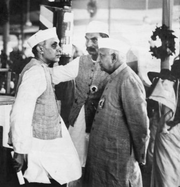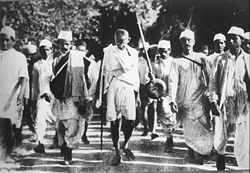Rajendra Prasad
| Dr. Rajendra Prasad डा॰ राजेन्द्र प्रसाद |
|
 |
|
|
|
|
|---|---|
| In office 26 January 1950 – 13 May 1962 |
|
| Prime Minister | Jawaharlal Nehru |
| Vice President | Sarvepalli Radhakrishnan |
| Preceded by | Office Created |
| Succeeded by | Sarvepalli Radhakrishnan |
|
|
|
| Born | 3 December 1884 Jiradei, Bihar, British India |
| Died | 28 February 1963 (aged 78) |
| Political party | Indian National Congress |
| Spouse(s) | Rajvanshi Devi |
Dr. Rajendra Prasad (Hindi: डा॰ राजेन्द्र प्रसाद) (3 December 1884 – 28 February 1963) was the youngest son of Mahadev Sahay from the village Ziradei, then the Saran district of Bihar. Dr. Prasad is considered to be one of the architects of the Indian Republic, having drafted its first constitution and serving as the first president of India.
During the independence movement, he left his law work and joined the Congress Party, playing a prominent role in the Indian Independence Movement. He served as the president of the Constituent Assembly that drafted the first constitution of the Republic, which lasted from 1948 to 1950. He also briefly served as a cabinet minister in the first Government of the Indian Republic.
He was a vegetarian [1].
Contents |
Early life
Dr. Rajendra Prasad, son of Mahadev Sahai, was born in Zeradei village, in the Saran district of Bihar, on 3 December 1884. He was the youngest in a large family, & was close to his mother and eldest brother. He was known as "Rajen" to his family and friends. His father, Mahadev Sahay, was a scholar of both the Persian and Sanskrit languages, while his mother, Kamleshwari Devi, was a religious woman. Zeradei's population was diverse, with both Muslims and Hindus living in relative harmony.
Student Life
When Rajendra Prasad was five years old, his parents put him under a Mawlawi, an accomplished Muslim scholar, to learn the Persian language, followed by Hindi and arithmetic. After the completion of traditional elementary education, Rajendra Prasad was sent to the Chhapra District School. At the age of 12, Rajendra Prasad was married to Rajavanshi Devi. He, along with his elder brother Mahendra Prasad, then went on to study at T.K. Ghosh's Academy in Patna.
Since childhood, Rajendra Prasad was a brilliant student. He placed first in the entrance examination to the University of Calcutta and was awarded Rs.30 per month as a scholarship. In 1902, Rajendra Prasad joined the Presidency College. He was initially a student of science and his teachers included Jagadish Chandra Bose and Prafulla Chandra Roy. Later he decided to focus on the arts. Prasad lived with his brother in the Eden Hindu Hostel. A plaque still commemorates his stay in that room. Dr. Rajendra Prasad was instrumental in the formation of the Bihari Students' Conference in 1908. It was the first organization of its kind in the whole of India, which would later produce many of the important figures of Bihar.
In 1915, Rajendra Prasad graduated with a Masters in Law, passing his examination with honors. He then went on to complete his Doctorate in Law.
Career
As a teacher
Rajendra Prasad served in various educational institutions as a teacher. After completing his MA in economics, Dr. Prasad joined as a professor at the Bhumihar Brahman College in Muzaffarpur, on July 1908 and later went on to become the principal. However later on he left the college for his legal studies. In Kolkata too he worked as Professor of Economics.
As a lawyer
Rajendra Prasad practiced law and pursued studies at Bhagalpur in Bihar and eventually emerged as a popular and eminent figure of the region. In 1916, Rajendra Prasad joined the High Court of Bihar and Orissa. Such was his intellect and his integrity, that often when his adversary failed to cite a precedent, the judges would ask Rajendra Prasad to provide a precedent.
During the Independence Movement

Dr. Prasad was drawn into the Indian independence movement soon after starting his career as a lawyer. During one of the fact-finding missions at Champaran, Mahatma Gandhi asked him to come with his volunteers. Rajendra Prasad was so greatly moved by the dedication, courage, and conviction of Mahatma Gandhi that he quit his duties in the university to aid the movement. He also responded to the call by Gandhi to boycott Western educational establishments by asking his son, Mrityunjaya Prasad, to drop out of his studies and enroll himself in Bihar Vidyapeeth, an institution he along with his colleagues founded on the traditional Indian model[2].
During the course of the independent movement, he formed a friendship with Dr. Rahul Sankrityayan, the great Indian writer, freedom fighter, and polymath. In many of his articles he mentioned about his meeting with Dr. Rahul Sankrityayan and narrated about their close friendship and Rahulji's love toward his nation. He wrote articles for the revolutionary publications Searchlight and the Desh and collected funds for these papers. He toured widely, explaining, lecturing, and exhorting the principles of the independence movement.
He took an active role in helping the affected people during the 1914 floods that struck Bihar and Bengal. When the earthquake of Bihar occurred on 15 January 1934, Rajendra Prasad was in jail, During that period, he passed his responsibility to his close colleague and eminent Gandhian Dr. Anugrah Narayan Sinha.[3] He was released two days later, and set himself for the task of raising funds to help the people. The Viceroy of India had raised his own fund, though Rajendra Prasad's fund collected over 38 Lakhs (Rs. 3,800,000), three times what the Viceroy raised. During the 1935 Quetta earthquake, when he was forbidden to leave the country, he set up relief committees in Sindh and Punjab.
He was elected as the President of Indian National Congress during the Bombay session in October 1934. He again became the president when Netaji Subhash Chandra Bose resigned in 1939.
After India became an independent republic in 1950, he was elected as the first President of India. Prasad acted independently of politics, following the expected role of the president that the constitution set down. Following the tussle over the enactment of the Hindu Code Bill, he took a more active role in the affairs of the nation. He set several important precedents for later presidents to follow.
In 1962, after twelve years as the president, he announced his decision to retire. He was subsequently awarded the Bharat Ratna, the nation's highest civilian award.
Rajendra Prasad died on 28 February 1963 [4]
Further reading
- Rajendra Prasad, first President of India, by Kewalram Lalchand Panjabi. Published by Macmillan, 1960.
- Rajendra Prasad: twelve years of triumph and despair, by Rajendra Lal Handa. Published by Sterling Publishers, 1979.
- Dr. Rajendra Prasad, Correspondence and Select Documents, by Rajendra Prasad, Valmiki Choudhary. Published by Allied Publishers, 1984. ISBN 8170230020. Excerpts (Vol. 1-Vol. 10)
- Dr. Rajendra Prasad
by India Parliament. Lok Sabha. Published by Lok Sabha Secretariat, 1990.
- Rajendra Prasad and the Indian freedom struggle, 1917-1947, by Nirmal Kumar. Published by Patriot Publishers, 1991. ISBN 8170501288.
- Dr. Rajendra Prasad: Political Thinkers Of Modern India, by V. Grover. Published by Deep & Deep Publications, 1993.
- First Citizens of India, Dr. Rajendra Prasad to Dr. Shanker Dayal Sharma: Profile and Bibliography, by A. B. Kohli. Published by Reliance Pub. House, 1995. ISBN 8185972710.
References
- ↑ Rukmini Devi Arundale, M.P., "Welcome Address", 15th World Vegetarian Congress 1957
- ↑ Atul Sethi, "Distant dads?" The Times of India (Aug 12 2007)
- ↑ Kamat. "Great freedom Fighters". Kamat's archive. http://www.kamat.com/kalranga/freedom/congress/c127.htm. Retrieved 2006-02-25.
- ↑ http://www.indianpoliticians.com/profile/1/ Indian Politicians Biography
External links
- Nation remembers Rajendra Prasad on 125th birth anniversary
- India ignored Rajen Babu
- Tributes to first president on 124th birth anniversary
- Works by or about Rajendra Prasad in libraries (WorldCat catalog)
| Political offices | ||
|---|---|---|
| Preceded by Governor-General of India Chakravarthi Rajagopalachari |
President of India 26 January 1950 - 13 May 1962 |
Succeeded by Sarvepalli Radhakrishnan |
|
||||||||||||||
|
|||||||||||||||||
|
||||||||||||||||||||||||||||
|
|||||||





